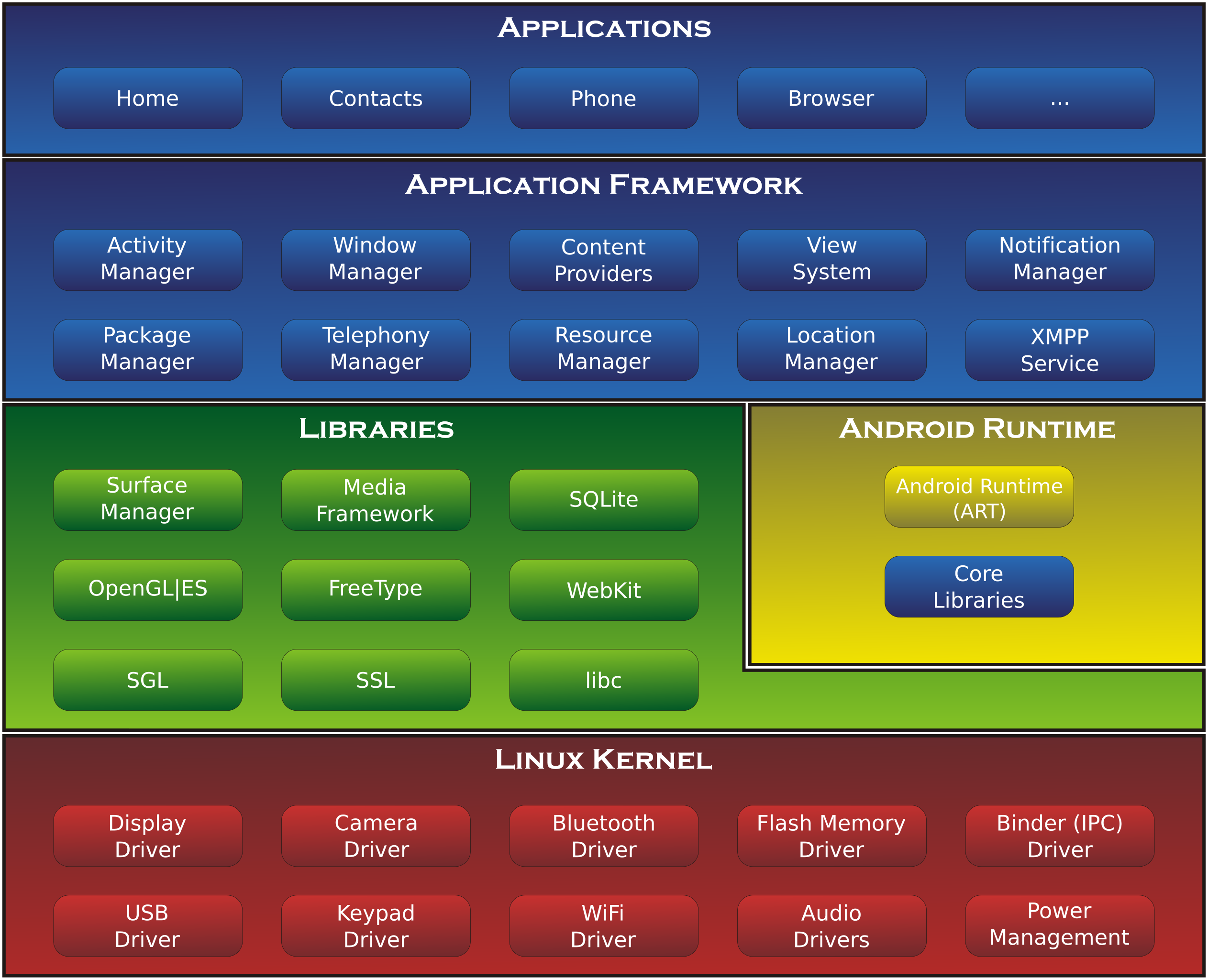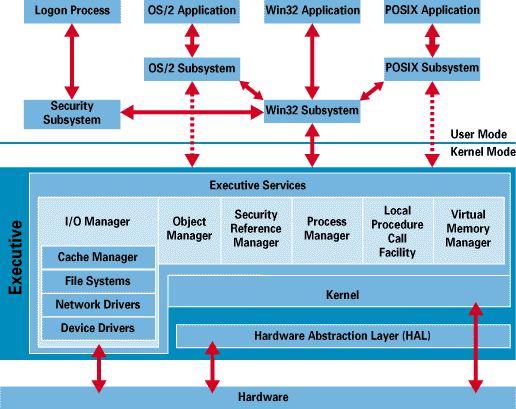OS | Operating System Structure
Operating System: Design and Implementation course notes from CCU, lecturer Shiwu-Lo.
在這個章節有以下主要大綱
- OS Service
- Graphical User Interface & Text-based User Interface
- System calls
- OS Structure
- Profiling/Debugging an OS Kernel
OS Service
2.1 Purpose of OS
一台作業系統的主要服務是使對於 User 而言 Hardware 變的更好使用,對 Designer 而言能提高系統使用率
Simple to use
- Communications
- 同一台電腦內部 Process 之間的 Communications(IPC),例如: copy and paste
- 跨電腦之間的通訊,例如: Network neighborhood, Network file system(NFS)
- Error detection
ptrace 是一種 System call,允許一個 Process 觀察另一個 Process,gdb 的底層就使用 ptrace 實現
- 提供使用者操作介面,例如: Gnome, KDE …
- 載入應用程式的能力,例如: execve()
- 多功能的作業系統,最少要能識別「執行檔」的檔案格式
- 部分嵌入式系統 Kernel 與 User application 編譯在同一個 mage,task 即為這個 mage 中的一個 Function, 這時候就不需要「執行檔」
- 處理 I/O 的能力,例如: 各種 Driver
- 檔案系統,例如: OS 將 Disk 上的一個 Block 抽象為 File,再將 File 抽象為 Folder,Folder 中可以放入 File
Increase efficiency
- 分配各種資源,例如: Memory 僅有 4GB,A 程式需要 3.2GB,B 程式需要 1.4GB,如何分配「有限」的 Memory
- Debian 上可以透過
free -h,cat /proc/swaps查看 swap 使用狀況
- Debian 上可以透過
- 統計資源的使用率,例如: 可以使用 htop 監視 CPU、DRAM、I/O 等效能,使用率
- Protection,確保 Process 只能擁有 OS 所分配的資源,Process 各自獨立,不會受到非法的干擾·
- Security,確保 User Login 後只能存取自己的資源,例如: 存取他人的家目錄
2.2 User interface
GUI:
- GUI 將許多命令以 Icon 的形式表示,並且大部分可以 Drag and drop(拖動)的方式
- 再輸入方式包含:
- 滑鼠、觸控面板、觸控螢幕、多點觸控的直覺化控制
CLI:
- Text-mode 雖然需要時間學習,但能很準確的下達命令
- 也可以將命令組合成 Batch program,例如: shell script
- Text-mode 比 GUI 更穩定
- 可以使用輕量級的 Remote connection,例如: ssh
- Text-mode 也可以結合指標裝置(例如: 滑鼠),也可以使用 Library(例如: ncurses) 模擬 GUI 介面(例如: Linux kernel memuconfig)
System Call
2.3 System call
System call 是 OS Kernel 對外開放的 API
- 注意恐龍書將 System call 定義為 OS 對外開放的 API
- 但 OS 涵蓋非常廣泛,因此 System call 應該限定於 Kernel 提供的 API
Linux system call
Linux 所有的 System call 可以到這個路徑去尋找 /arch/x86/entry/syscalls/syscall_64.tbl,或是到 Linux 的 syscalls(2) — Linux manual page, 前四個 System call 為: 1. read, 2. write, 3. open, 4. close
Call System call
- 可以透過 libc(C standard library) 呼叫 System call
- 例如: read, write, open, close
- Linux 的 Man page 中,volume 2 即為 System call 的說明
- 例如:
man 2 read,這裡要注意是否有安裝sudo apt-get install manpages-dev
- 例如:
- 少數 System call 並未包含在 Linux 的 libc 內,這時候需要自已寫出來
#define_GNU_SOURCE /* See feature_test_macros(7) */
#include <unistd.h>
#include <sys/syscall.h> /* For SYS_xxx definitions */
long syscall(long number, ...);
gettid() - libc 未實現的 System call
在 Linux 中:
- Process 都有一個 pit_t 可以透過 getpid() 獲得
- POSIX Thread(pthread) 也有 pthread_t 可以透過 pthread_self() 獲得,
- 但是如果我想要 P1 的 thread2 與 P2 的 thread1 通訊,我們就需要一個真實的 Thread ID(TID),這時候就要透過 System call 來獲得 tid,使用
syscall(SYS_gettid)
#define_GNU_SOURCE
#include <unistd.h>
#include <sys/syscall.h>
#include <sys/types.h>
#include <signal.h>
int main(int argc, char *argv[]) {
pid_t tid;
/* gettid() returns ths caller's thread ID(TID).
There is no glibc wrapper for this system call. */
tid = syscall(SYS_gettid);
/* int tgkill(int tgid, int tid, int sig); send a signal to a thread. */
syscall(SYS_tgkill, getpid(), tid, SIGHUP);
}
Call System Call Method(From assembly language)
Call System call 的方式如下(Calling convention):
| arch/ABI | syscall# | arg1 | arg2 | arg3 | arg4 | arg5 | arg6 | ret. val. |
|---|---|---|---|---|---|---|---|---|
| arm64 | x8 | x0 | x1 | x2 | x3 | x4 | x5 | x0 |
| x86-64 | rax | rdi | rsi | rdx | r10 | r8 | r9 | rax |
syscall# System call 編號
ret. val. System call return value
Call System call 的組合語言如下: ARM: svc #0, x86-64: syscall
movq $60, %rax; // Call NO.60 System call, exit()
movq $2, %rdi; // arg1 = 2, means exit(2)
syscall; // Change to kernel mode, call System call
延伸閱讀: The Linux Kernel Module Programming Guide: System call
2.4 Special cases of system calls
首先要討論 System call overhead 這是為什麼把某些 Module 放在 Kernel 的速度會提升許多的原因
System call 主要的 Overhead 來自於:
- CPU 進行 Mode change 的時候,此時 CPU 有同時數個指令在執行,切換時或許需要 flush 所有執行到一半的指令
- Kernel 需要將 User space 的所有暫存器存在 Kernel stack(每一個 Task,於 Kernel 中有自己的 Stack,注意,不是 User mode stack)
- 檢查權限,在 System call 之前還要檢查 Task 是否有權限執行該 System call
- 依照 Kernel 內部的 Calling convention,呼叫實現該 System call 的 Function,例如:sys_read() => do_read()
因為這些 Overhead 使得在 User space 執行的程式,速度會比在 Kernel space 執行的程式慢許多
vDSO
因此 Linux 的設計者會希望盡可能地降低 Overhead,vDSO(Virtual Dynamic Shared Object) 是可以將 Kernel space 的資訊,直接映射到 User space
- 如果該 System call 並沒有牽涉「安全性」,那就直接把 Kernel space 中的資訊寫入 User space,讓程式可以透過 Function call 的方式取得該資料
- 會時常變動,但又沒有機密性的資訊:
- __vdso_clock_gettime
- __vdso_getcpu
- __vdso_gettimeofday
- __vdso_time
- 不會變動,但也沒有機密性的資訊:
- 第一次呼叫時,真的產生 System call,libc 記錄下該 Function 的值
- 第二次呼叫時,由 libc 直接回傳,例如:getpid()
/proc/pid/maps
/*...*/
7ffe6b98e000-7ffe6b9af000 rw-p 00000000 00:00 0 [stack]
7ffe6b9fa000-7ffe6b9fd000 r--p 00000000 00:00 0 [vvar]
7ffe6b9fd000-7ffe6b9ff000 r-xp 00000000 00:00 0 [vdso]
ffffffffff600000-ffffffffff601000 r-xp 00000000 00:00 0 [vsyscall]
這裡每行都由以下內容組成: address、perms、offset、dev、inode、pathname
- vsyscall: 功能等同於 vdso,但是較為古老,並有安全性問題(No support ASLR)
- vdso: 存放可呼叫的 vDSO Function,例如: clock_gettime()
- vvar: 存放 Kernel space mapping 到 User space 的資料,例如: clock_gettime() 的 cur_time
If not using vDSO
下圖左是沒有 vDSO clock_gettime() 想要取得時間的流程,要去呼叫 timekeeping_update() 更新 cur_time,因此需要 Mode change 進入 Kernel mode。 而圖右就將這個資料結構直接映射到 User space,clock_gettime() 呼叫 timekeeping_update() 一樣會去更新 cur_time,但直接去讀 vDSO 中的資料,這樣的話速度就跟 Function call 一樣快了。


vDSO Problem
- 資料存放在 vvar 不一定就是 User 要的資料格式,例如:
- vvar 中放的是從開機到現在經過多少個 Machine cycles,但是 gettimeofday() 的回傳值是自 1970/1/1 至今經過多少秒,所以這裡是有座資料轉換的
- vDSO 內部的程式碼會做適當的資料轉換
OS Structure
2.5 Monolithic system
- 許多著名的 OS 都是 Monolithic system,例如: Linux, FreeBSD, Solaris
- 目前這些作業系統都支援動態載入 Kernel module 的功能
- Linux 的 lsmod 可以列出目前已經載入到 Kernel 的 module
這裡列出 Linux Kernel 中與 File system 相關的 module
$ lsmod | grep fs
autofs4 45056 2
btrfs 1294336 2
xor 24576 1 btrfs
raid6_pq 114688 1 btrfs
libcrc32c 16384 1 btrfs
2.6 In Linux Object
Linux 雖然是使用 C 撰寫的,但是在 Kernel 中充滿了 Object-oriented(OO) 的概念,Object-oriented analysis and design(OOAD)物件導向分析與設計
下面是一個 Linux Kernel 中常見的 OO 概念,並且使用 container_of 來取得這個 Linked list 的起始 address(Linked list head)
struct parport_driver {
const char *name; /*property*/
void (*attach) (struct parport *); /*method*/
void (*detach) (struct parport *); /*method*/
struct list_head list; /*inherit list_head*/
};
struct list_head {
struct list_head *next, *prev;
};
#define list_entry(ptr, type, member)
container_of(ptr, type, member)
container_of
/**
* container_of - cast a member of a structure out to the containing structure
* @ptr: the pointer to the member.
* @type: the type of the container struct this is embedded in.
* @member: the name of the member within the struct.
* */
#define container_of(ptr, type, member) ({ \
const typeof( ((type *)0)->member ) *__mptr = (ptr); \
(type *)( (char *)__mptr - offsetof(type,member) );})
container_of 主要是透過成員來獲取該 struct 的起始位置,詳細可以看 Linux Kernel Macro container_of 跟延伸閱讀
Linux kernel 雖然是使用 C 語言寫的,但在裡面充斥著 OO 的概念,當然有部分要跟底層溝通所有沒有完全 OO
2.7 Layered approach
Layered approach 在 OS 的缺點是,並不一定能切出 Layer,跟 Network 不太一樣
- 將系統分成 N 層
- 第 N 層可以使用第 N-1 層的功能,不可以使用 N+1 層的功能

例如 I/O memagement 需要 Buffer 因此需要 Memory management,Memory management 有時也需要將 Memory 寫到 Disk,因此需要 I/O management,這樣就很難分層
2.8 Hardware Abstraction Layer
常見的 Andriod OS 與 Windows 架構如下:


Andriod:
- 可以看到 Libraries 被放置在中間層,是因為為了能給各家廠商商業化,而最上方是 Apach License 就是隨意給人更改的部分, 可以看到 Hardware Abstraction Layer(HAL) 被放置在中間層,照常理來說應該放在 Hardware 與 Software 之間,放在這裡或許是想要把 Kernel 有替換的的彈性。
Windows:
- Windows 的 HAL 就被放置在 Kernel 與 Hardware 之間,抽象層的目標是,例如: 希望 Kernel 中沒有 Assembly,不要太跟 Device 相關。
- Kernel 之上包含著 Virtual Memory Manager(把硬體相關的部分抽出,另外一個目錄)
Last Edit
10-10-2023 23:21